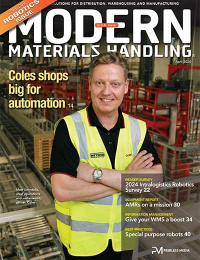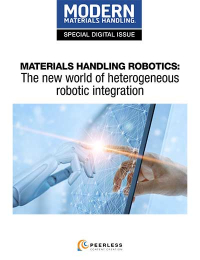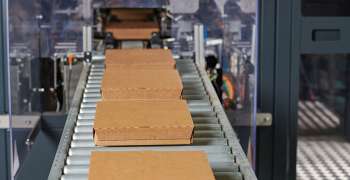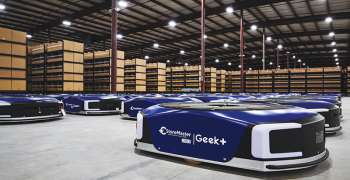Arkestro introduced predictive procurement at Optimal22
Transparency, trust and a new way to work with suppliers were on the agenda at Optimal22.
Latest Material Handling News
Learn from lift truck service history Two voices of reason on pallet materials 60 Seconds with Bob Trebilcock, outgoing executive editor, Modern Materials Handling The reBound Podcast: How Pitney-Bowes is innovating with autonomous vehicles. Packaging Corner: Be open to change More BlogsWho the heck is Arkestro? And, what the heck is predictive procurement orchestration? Those were the two questions that took me to Optimal22 this past week, a one-day event in Las Vegas billed as the “The Leadership Summit for Predictive Procurement.”
The first is the easier of the two questions to answer. The company was co-founded 5 or so years ago by CEO Edmund Zagorin, as Bid Ops. The company description used to read: “Bid Ops removes the headache of collecting, comparing and benchmarking many quotes from many vendors. Whether procuring from a small group of long-time supplier partners or a diverse global portfolio, Bid Ops AI will perform basic optimizations around geography and seasonality, alongside more complex optimizations for negotiation behavior, risk profile, logistics and packaging, as well as optimizing for multi-award or long tail bids.”
Fast forward and the company attracted some experienced and sophisticated investors, including Rob DeSantis, a co-founder of Ariba and an early investor in LinkedIn, that put in $26 million in an A Series round, and a board that includes Jeffrey Immelt, the former CEO of GE. It was rebranded as Arkestro – think orchestration – at a company conference in New York City last May. Among other accolades, Bid Ops/Arkestro was a Gartner Cool Vendor.
As to just what is predictive procurement, I’ll give you the short version here, but to learn more, you can link to a White Paper here. The concept, as Zagorin explained at the conference and later in an interview, is to use emerging technologies such as AI, machine learning, game theory and behavioral science to shorten and automate the procurement process, especially with suppliers with whom you already have a relationship and a history. But not exclusively. “The idea is to encourage faster agreements that create trust with suppliers, who will know they are going to get an order earlier in the process,” Zagorin said.
So, how does it do that? Arkestro is a middleware platform that sits just above your systems of record, such as your ERP system, and, perhaps, just below your procurement systems. When a buyer decides to make a purchase, he or she can enter in the product they want to buy as well as other relevant information determined by the buyer. That could include the quantity, the delivery requirements, packaging requirements and any other special contractual agreements. Arkestro then does its thing and examines the organization’s history with that item or items the suppliers it has qualified to provide the part. Once it works its magic it arrives at a suggested price for the item and emails that information – including the recommended price – to suppliers.
The suppliers can then review the potential order and accept the price, suggest a higher price or, if they’re really hungry, key in a lower price. The idea, as I understand it, is first to automate and hence speed up the process and build trust into the system by being transparent with suppliers. Speed also comes by eliminating what many may view as the tedious process of ping-pong negotiations.
According to Zagorin, it’s not going to work for every opportunity. During his presentaiton, he said that since going live, suppliers accepted the suggested price just under 14% of the time. In a follow up interview, he said the 14% was certainly a time saver, but the real savings to the organizations came from about 2% of the bids that realized significant cost reductions. That was either as a result of the system suggesting a price with significant savings, or the supplier keying in an even lower price.
There were presentations from several customers, including Bel Brands USA, Westfall Technik and BASF, on how they were using the tool to generate cost savings. Linda Chuan, the head of strategic sourcing and procurement at Box, spoke about how she was using the dashboards of her procurement spend with diverse suppliers for reporting purposes to customers and apprising her board on the organization’s advancements in its supplier diversity initiative. Bidding opportunities might come later.
Apart from discussions about the Arkestro tool, there were several themes echoed by the presenters, all of whom were senior procurement leaders, that reinforced messages I’ve heard at other procurement conferences, such as ISM last May, and in discussions with other senior procurement leaders.
Procurement owns not just supplier diversity, but other ESG initiatives: As mentioned above, Chuan’s presentation was all about supplier diversity, including as Justice Coalition in the Bay area that includes Box, Slack, Zoom, Intuit and Tinder. But the importance of sustainability also came up in other presentations.
Supplier relationship management has never been more important: In a blog on SCMR.com, Len DeCandia, the former global CPO for Johnson & Johnson, argued that in the coming years, the companies that invest in SRM are the companies that will win in the marketplace because they will have supply. Although Zagorin didn’t put it that way, on several occasions he noted that Arkestro was really a supplier-facing tool. One presenter asked for a show of hands for how many in the audience had sent out an RFP and got crickets in return. The point was that the supply base is stretched as thin as the customer base and just doesn’t have time to respond to all the quotes coming its way. So, suppliers are going with their best customers. That’s SRM.
Trust and transparency might just be the coin of the realm: John Henke, a Michigan-based academic and researcher, has published a supplier trust index of the automotive industry for years. The index surveyed the Tier 1 suppliers to the six largest U.S. automakers and basically asked them about their relationships with the automakers – how much did they really trust them? Henke’s thesis, which he was able to correlate with the stock prices of the automakers over the years, was that the OEMs that had the highest trust index scores got the first crack at supplier innovation that led to market share. In a completely unrelated field, McDonald’s has long attributed its success to the relationships that it has with its suppliers, which it considers integral to its performance. That’s a long-winded way of swaying that the words trust and transparency came up in virtually every presentation at the Arkestro event.
My last takeaway is that for all the excitement around digital transformation, and it is exciting, the ultimate success at any organization may depend on how well it is able to integrate new, transformational technologies with an existing infrastructure. The best example at Arkestro was an automaker who described automating some of its procurement practices only to end up manually entering the results into a 20 year old system of record that it just couldn’t get away from.
I found it a fascinating event. And while I might still be fuzzy on predictive procurement, just as I’m a little fuzzy on probabilistic planning, it’s a concept to keep an eye on for the future.

Article Topics
Blogs News & Resources
Learn from lift truck service history Two voices of reason on pallet materials 60 Seconds with Bob Trebilcock, outgoing executive editor, Modern Materials Handling The reBound Podcast: How Pitney-Bowes is innovating with autonomous vehicles. Packaging Corner: Be open to change 60 Seconds with Robert Martichenko of American Logistics Aid Network The reBound Podcast: Looking for talent in all the right places: How Essendant is revolutionizing recruitment More BlogsLatest in Materials Handling
Geek+ and System Teknik deploy PopPick solution for pharmacy group Med24.dk Beckhoff USA opens new office in Austin, Texas Manhattan Associates selects TeamViewer as partner for warehouse vision picking ASME Foundation wins grant for technical workforce development The (Not So) Secret Weapons: How Key Cabinets and Asset Management Lockers Are Changing Supply Chain Operations MODEX C-Suite Interview with Harold Vanasse: The perfect blend of automation and sustainability Consultant and industry leader John M. Hill passes on at age 86 More Materials HandlingAbout the Author
Subscribe to Materials Handling Magazine

Find out what the world's most innovative companies are doing to improve productivity in their plants and distribution centers.
Start your FREE subscription today.
April 2024 Modern Materials Handling

Latest Resources










